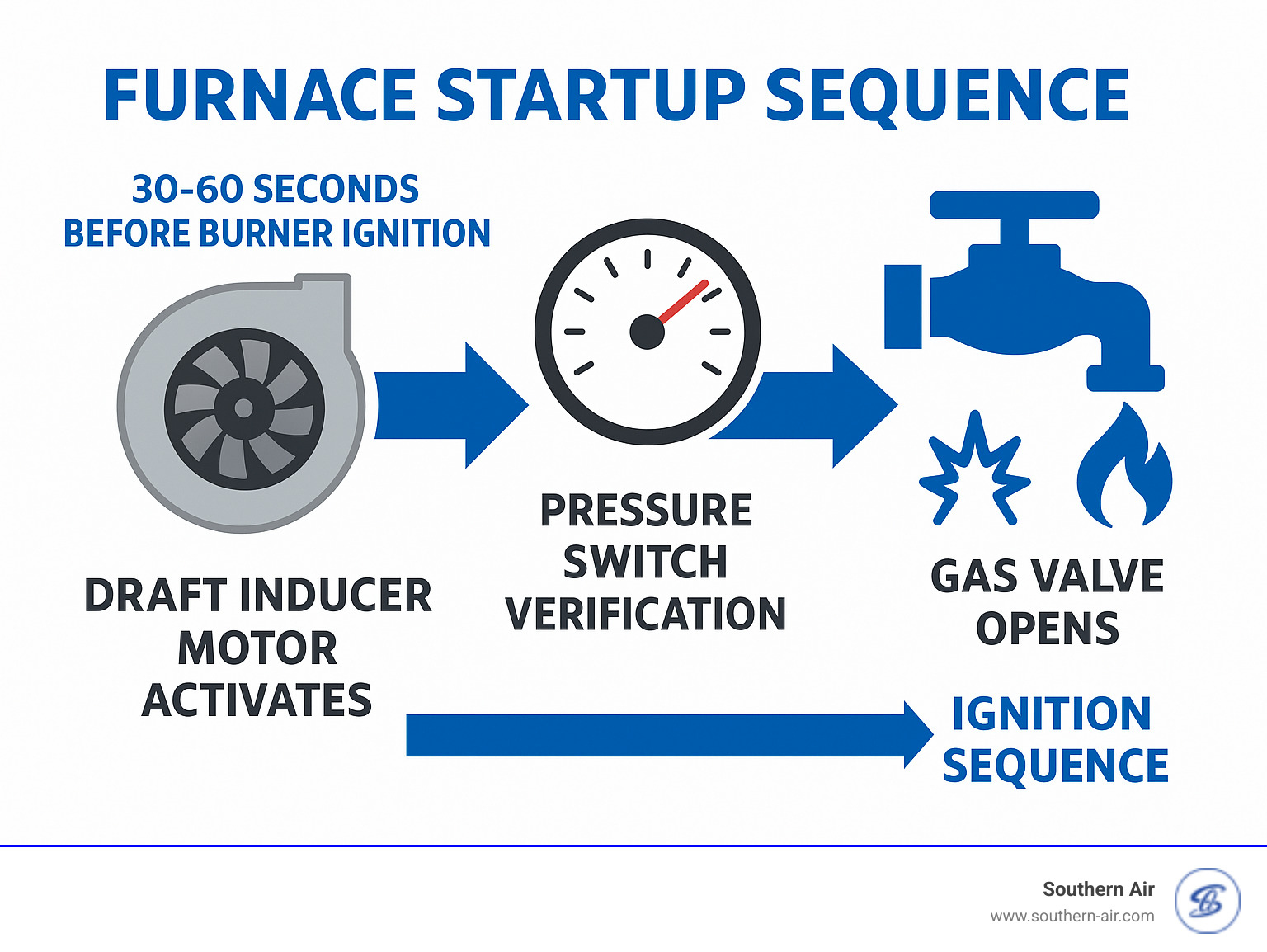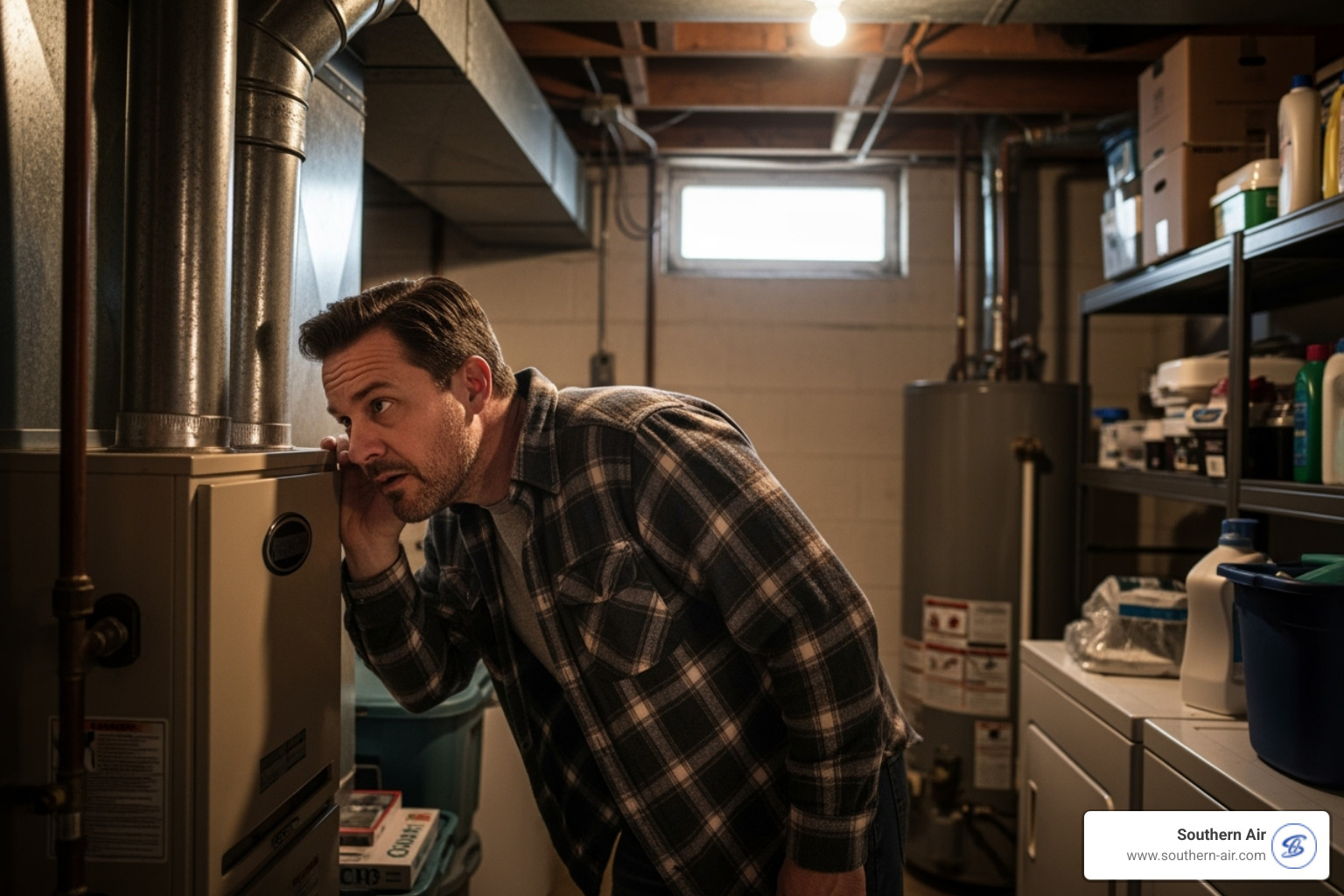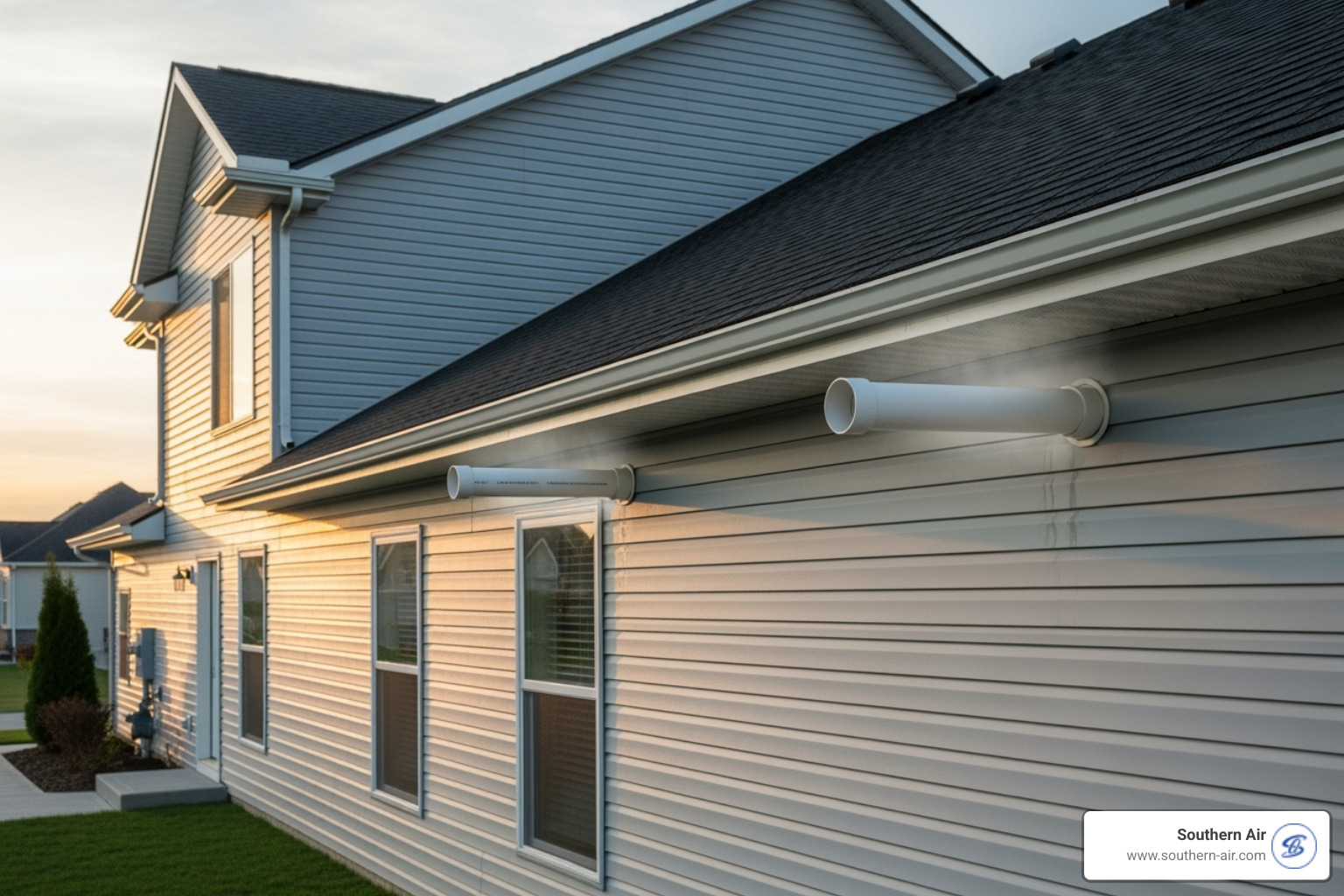Why Your Furnace Exhaust Fan is Critical for Safe Operation
When your furnace exhaust fan acts up, your entire heating system can shut down. This small but mighty component - also called a draft inducer motor - is what makes modern furnaces safe and efficient.
Quick Answer: What is a furnace exhaust fan?
- Primary function: Removes dangerous combustion gases from your home
- Location: Inside the exhaust flue at the end of the heat exchanger
- Timing: Turns on 30-60 seconds before your furnace ignites
- Safety role: Prevents carbon monoxide from entering your living space
- Efficiency role: Ensures proper air-to-fuel ratio for complete combustion
The draft inducer fan is essential for high-efficiency furnaces because their cooler exhaust gases don't rise naturally through the flue like older models. If this fan isn't working properly, your furnace's control board will prevent ignition, leaving you without heat.
Common signs your furnace exhaust fan needs attention:
- Furnace won't start or ignite
- Loud humming, grinding, or rattling noises
- Excessive noise that gets worse over time
- Furnace shuts down unexpectedly
Understanding this critical component and recognizing the warning signs of failure can save you from costly emergency repairs and keep your family safe from dangerous combustion gases.

The Critical Role of Your Furnace's Draft Inducer
Your furnace exhaust fan is the unsung hero of your heating system. Unlike the well-known heat exchanger or blower motor, the draft inducer often goes unnoticed until it fails. This component's job is to kick dangerous combustion gases out of your home.
Located at the end of the heat exchanger, the furnace exhaust fan fires up 30 to 60 seconds before your burners ignite. This pre-ignition purge clears leftover gases from the heat exchanger, ensuring a clean, safe burn.
It's important not to confuse the draft inducer with other furnace parts. Your heat exchanger handles the warming process, your gas valve controls fuel flow, and your blower motor circulates warm air. The draft inducer is the exhaust specialist, focused entirely on safely removing combustion byproducts, which is critical for both safety and efficiency.
For more technical details about how these systems work, check out this helpful Guide to Inspecting Draft Inducing Fans.
Ensuring Safe Venting of Combustion Gases
When your furnace burns natural gas, it produces byproducts, including the dangerous Carbon monoxide. This colorless, odorless gas is a silent killer.
Your furnace exhaust fan acts like a powerful vacuum, creating negative pressure in the combustion chamber. This suction pulls dangerous gases through the heat exchanger and out the flue pipe, far from your family.
Most modern furnaces have a pressure switch that acts as a safety referee. If the draft inducer isn't creating enough suction—perhaps it's failing or the flue is blocked—this switch won't close, and the furnace will not ignite. It's a safety feature that refuses to start an unsafe cycle.
This backdraft prevention system is your first line of defense against carbon monoxide poisoning. The negative pressure ensures gases always flow out of your home, not back into it. It's a simple but brilliant safety feature.
Maximizing Combustion and Furnace Efficiency
Safety is just half the story; the furnace exhaust fan also ensures your heating system runs efficiently. For your furnace to burn fuel effectively, it needs the perfect air-to-fuel ratio. The draft inducer provides a smooth, consistent exhaust flow, which allows the right amount of fresh air to enter for complete combustion. This means you get maximum heat from every bit of natural gas.
This is especially important for high-efficiency furnaces. These modern units extract so much heat that the exhaust is much cooler than in older furnaces. Cool exhaust won't rise naturally and needs a push from the furnace exhaust fan to get outside.
Thanks to this active venting, today's high-efficiency furnaces can achieve AFUE ratings over 90%. This means over 90 cents of every dollar you spend on gas heats your home. Without the draft inducer motor, this level of heat extraction wouldn't be possible.
Since 1992, these fans have been standard on new furnaces, making home heating both safer and more economical.
Troubleshooting Your Furnace Exhaust Fan: Signs and Solutions
When your furnace stops working on a cold morning, the furnace exhaust fan is often the culprit. At Southern Air, we frequently see homeowners wake up to a chilly house because their draft inducer motor has failed.
Understanding what to look and listen for can help you catch problems early, potentially saving you from emergency repairs. While homeowners can perform basic troubleshooting, it's crucial to know when to call professionals for your safety.
Modern furnaces often display error codes, but even without them, your furnace communicates through sounds and performance changes. Learning to interpret these signs is helpful when problems arise.

Common Noises from a Failing furnace exhaust fan
Your furnace should run quietly, so unusual noises are a clear sign something is wrong. The furnace exhaust fan has its own vocabulary of sounds that indicate specific problems.
Whirring or grinding sounds are often the first sign that the draft inducer's motor bearings are wearing out. The bearings that allow smooth rotation can dry out or collect debris over time. What starts as a subtle whir can become an unmistakable grinding noise.
Rattling noises usually mean something is loose or foreign objects like leaves and twigs have entered the fan housing through exterior vents. A loose fan blade can also create a distinctive rattle with each rotation.
Loud humming without movement is frustrating; you can hear the motor trying to work, but the fan blades aren't spinning. This often points to electrical issues, like a problem with the start capacitor, or a seized motor.
Any noise that gets progressively worse is an early warning. This escalation usually indicates internal components are failing, and addressing it early can save you from more expensive repairs.
What to Do When Your furnace exhaust fan Won't Spin
A furnace that won't start is incredibly frustrating as the temperature in your home drops. When your furnace exhaust fan won't spin, the entire heating system halts due to safety mechanisms.
Start with the basics by checking your power sources. It may seem obvious, but many service calls are resolved by checking a tripped breaker or the thermostat. Ensure the thermostat is set to heat and the furnace power switch is on.
Listen carefully when you turn up your thermostat. If you hear startup sounds but nothing follows, the control board may be failing to start the inducer motor, which must spin before ignition.
Safety first - always turn off power to your furnace at the circuit breaker before any inspection. Once it's safe, locate the draft inducer motor. Look for obvious obstructions like debris or dust that might prevent the fan from spinning.
Consider the electrical components if the fan is clear but won't start. A faulty start capacitor is a common culprit. Other issues like faulty motor windings or control board problems require professional diagnosis.
While these basic checks are helpful, you're dealing with gas and electrical systems. If in doubt or the problem persists, call the professionals at Southern Air. We have the tools and experience to diagnose and repair these issues safely.
How the Draft Inducer Works with Different Venting Systems
The world of home heating has changed dramatically, and your furnace exhaust fan has evolved with it. At Southern Air, we've seen this evolution since 1946, from simple natural draft systems to today's sophisticated models. The way your draft inducer works depends on your furnace type, and understanding this difference helps with system maintenance.
Modern building codes have also shaped how these venting systems work, making the draft inducer a critical component in modern heating.
High-Efficiency (Condensing) Furnaces

White PVC pipes on your home's exterior indicate a high-efficiency condensing furnace. These units are so effective at extracting heat that the leftover exhaust gases are very cool.
This cool air lacks the energy to rise up a chimney on its own, which is why the furnace exhaust fan is essential for these systems. The draft inducer creates a "sidewall power vent" system, actively pushing cooler gases through PVC pipes that typically exit through a sidewall.
This forced venting is necessary because the secondary heat exchanger cools the exhaust so much that it condenses into acidic water. PVC pipes handle this corrosive exhaust better than traditional metal, but they absolutely require the inducer fan to move the gases out of your home safely.
Standard-Efficiency (Non-Condensing) Furnaces
Older, standard-efficiency furnaces work like a traditional fireplace. Hot exhaust gases naturally rise through a metal flue pipe in the roof, a system based on the principle that hot air rises.
Most of these furnaces operate without a draft inducer, relying on natural convection. The metal flue acts like a chimney, drawing in fresh air while expelling used gases.
However, some natural draft systems can benefit from mechanical assistance. In homes with a long flue run or incorrect pipe sizing, natural convection can struggle. In these cases, adding a furnace exhaust fan can assist the process.
This isn't a common upgrade and should only be done after a professional diagnosis. Adding an inducer won't automatically improve performance, as these systems were designed for natural draft. Modifying them requires careful consideration of the entire venting system.
The key difference is that high-efficiency furnaces require forced venting, while standard-efficiency furnaces typically only need it to correct an underlying venting issue.
Essential Maintenance for Your Draft Inducer Motor
Your furnace exhaust fan works hard every heating season and needs attention to run smoothly. At Southern Air, we know preventative care can save homeowners from expensive emergency repairs and heatless nights.
Regular maintenance is about more than avoiding breakdowns; it's about safety and efficiency. While some simple checks can be done by homeowners, nothing beats the thorough care of an annual professional tune-up. Since 1946, we've learned the best time to service your furnace is before it breaks down.
Homeowner Maintenance Checks
You don't need to be an HVAC expert to monitor your furnace exhaust fan. A few simple observations can help you spot trouble early.
Start with your ears. The draft inducer starts first when your furnace kicks on, usually with a gentle whir. If you hear grinding, rattling, or loud humming instead, your furnace is signaling a problem. These sound changes are often gradual, so knowing what's normal is key.
Take a peek around the furnace when it's off and cool. Look for debris around the fan housing, like dust or leaves. If you spot anything, turn off the power at the breaker before cleaning. A small brush or vacuum can remove accumulated dust.
Don't forget the outside. Locate your furnace exhaust vent—either PVC pipes on the side of your house or a metal flue on the roof. Ensure nothing blocks these vents, especially after storms or snow. A blocked exhaust will prevent the furnace from starting due to its safety switches.
Professional Servicing
While homeowner maintenance helps, there's no substitute for a trained HVAC professional. During our annual furnace tune-ups, we give your furnace exhaust fan the thorough attention it needs.
Our technicians start with the electrical connections, checking for tightness and corrosion. Loose or corroded connections can cause intermittent issues or complete motor failure.
We clean the fan blades thoroughly, removing accumulated dust and soot. Even a thin layer of buildup reduces efficiency and strains the motor. Clean blades move air more effectively, improving system performance.
Motor lubrication gets attention too. While many modern motors have sealed bearings, we'll assess your specific motor and provide lubrication if needed to reduce friction and extend its lifespan.
The pressure switch testing is crucial as it works with the draft inducer. We verify it accurately senses draft and will safely shut down the furnace if there's a problem, ensuring your safety systems work as designed.
Professional maintenance catches small issues before they become expensive problems. It's a small investment that prevents major headaches and keeps your system running safely and efficiently.
Frequently Asked Questions about Furnace Exhaust Fans
At Southern Air, we've helped Lynchburg homeowners with their heating systems since 1946, and questions about the furnace exhaust fan are common. Many wonder about this component that can unexpectedly leave them without heat.
What happens if a draft inducer motor fails completely?
When your furnace exhaust fan fails, your furnace will not ignite. The furnace's control board runs a safety checklist before every cycle. It waits for the inducer to create proper negative pressure, which is confirmed when the pressure switch closes.
If the furnace exhaust fan doesn't spin or create enough suction, the pressure switch stays open. The control board then halts the heating process, preventing the gas valve from opening and ignition from starting.
This safety lockout may be frustrating, but it protects you from dangerous carbon monoxide entering your home.
How much does it cost to replace a furnace inducer motor?
The cost to replace a furnace exhaust fan varies significantly. Several factors influence the final price, including your specific furnace model and age, as some parts are harder to source than others.
Labor costs also vary by region and job complexity. Sometimes a simple motor replacement can become more involved if other components are affected. A professional diagnosis can determine if you need a simple fix, like a new capacitor, or a full motor replacement.
We recommend getting a professional estimate from a trusted local company. At Southern Air, we believe in transparent pricing and will explain exactly what needs to be done and why, with no surprises.
Can I replace a furnace exhaust fan myself?
While the DIY spirit is strong, replacing your furnace exhaust fan is a job for professionals. There are serious safety concerns with DIY furnace work, as it involves both gas appliances and electrical components.
Carbon monoxide leaks are the biggest worry; if the exhaust system isn't properly sealed after installation, this deadly gas could enter your home. Electrical hazards are also a concern, as incorrect wiring can cause serious injury.
Even if the fan runs, improper venting can create ongoing safety issues. The draft inducer must work in harmony with the pressure switch and venting system. An incorrect installation can lead to bigger problems.
Furthermore, most furnace manufacturers require professional installation to maintain the warranty. A DIY repair could void it, leaving you responsible for much larger expenses.
Our certified technicians at Southern Air have the training and tools to handle these repairs safely and correctly. Let us handle the technical work while you stay warm and worry-free.
Conclusion
Your furnace exhaust fan is a small but mighty component that keeps your home safe and comfortable. This draft inducer motor removes dangerous combustion gases and helps your furnace burn fuel efficiently. Modern high-efficiency furnaces couldn't exist without it.
This guide explored how the fan creates negative pressure, ensures complete combustion, and defends against carbon monoxide. Whether you have a modern condensing furnace or an older system, the draft inducer is vital for safe operation.
The warning signs are clear: unusual noises, a furnace that won't start, or unexpected shutdowns. While you can perform basic checks, the electrical and gas components involved make professional service the smart choice for any repairs.
Southern Air has kept Lynchburg families warm since 1946. With decades of experience, we diagnose furnace problems, replace components, and ensure systems run safely. We understand the frustration of a broken furnace during cold Virginia winters.
Don't wait for a breakdown to address furnace exhaust fan issues. Regular maintenance and prompt professional service prevent small problems from becoming expensive emergencies. Your family's comfort and safety are too important to risk.
Ready to get your heating system back on track? Schedule your furnace repair in Lynchburg, VA with Southern Air today. We'll diagnose the problem, explain your options, and get your home cozy again.

